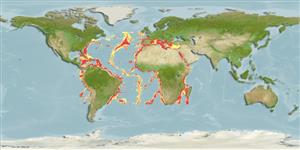Common names from other countries
Environment: milieu / climate zone / depth range / distribution range
Ecologia
Bentopelágico; intervalo de profundidade 200 - 3000 m (Ref. 1695). Tropical; 52°N - 35°S, 85°W - 46°E (Ref. 106956)
Atlantic, Mediterranean, Western Indian Ocean and the Pacific.
Length at first maturity / Tamanho / Peso / Idade
Maturity: Lm ? range ? - ? cm Max length : 2.5 cm ML macho/indeterminado; (Ref. 1695)
Mesopelagic or benthopelagic, but also found on the bottom at depth range to 1588 m, paralarvae found in mesopelagic and bathypelagic zones, far from coasts, with bottom depth ranging between 1,500 and 3,000 m. Adults live in groups in lower epipelagic and mesopelagic zones, common at depths between 200 and 300 m. Often found in areas inhabited by populations of red shrimps. Represents a sizeable component of the diet of several top predators, including dolphins, sharks, swordfish and tunas. Caught by pelagic nets and shrimp trawlers but of no commercial interest due to the low quantities available to fisheries (Ref. 1695).
Life cycle and mating behavior
Maturidade | Reprodução | Desova | Ovos | Fecundidade | Larvas
Members of the class Cephalopoda are gonochoric. Male and female adults usually die shortly after spawning and brooding, respectively. Mating behavior: Males perform various displays to attract potential females for copulation. During copulation, male grasp the female and inserts the hectocotylus into the female's mantle cavity where fertilization usually occurs. Life cycle: Embryos hatch into planktonic stage and live for some time before they grow larger and take up a benthic existence as adults.
Jereb, P. and C.F.E. Roper (eds.). 2005. (Ref. 1695)
Status na Lista Vermelha da IUCN (Ref. 130435)
Status no CITES (Ref. 108899)
Not Evaluated
Not Evaluated
Uso pelos humanos
| FishSource |
Ferramentas
Mais informação
Idade/TamanhoCrescimentoComprimento-pesoComprimento-comprimentoMorfologiaLarvasAbundância
Fontes da internet
Estimates based on models
Preferred temperature
(Ref.
115969): 3.7 - 14, mean 7.1 (based on 746 cells).
Vulnerabilidade
Low vulnerability (10 of 100).
Categoria de preço
Unknown.
